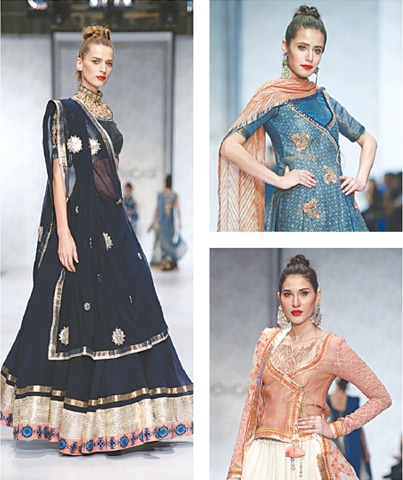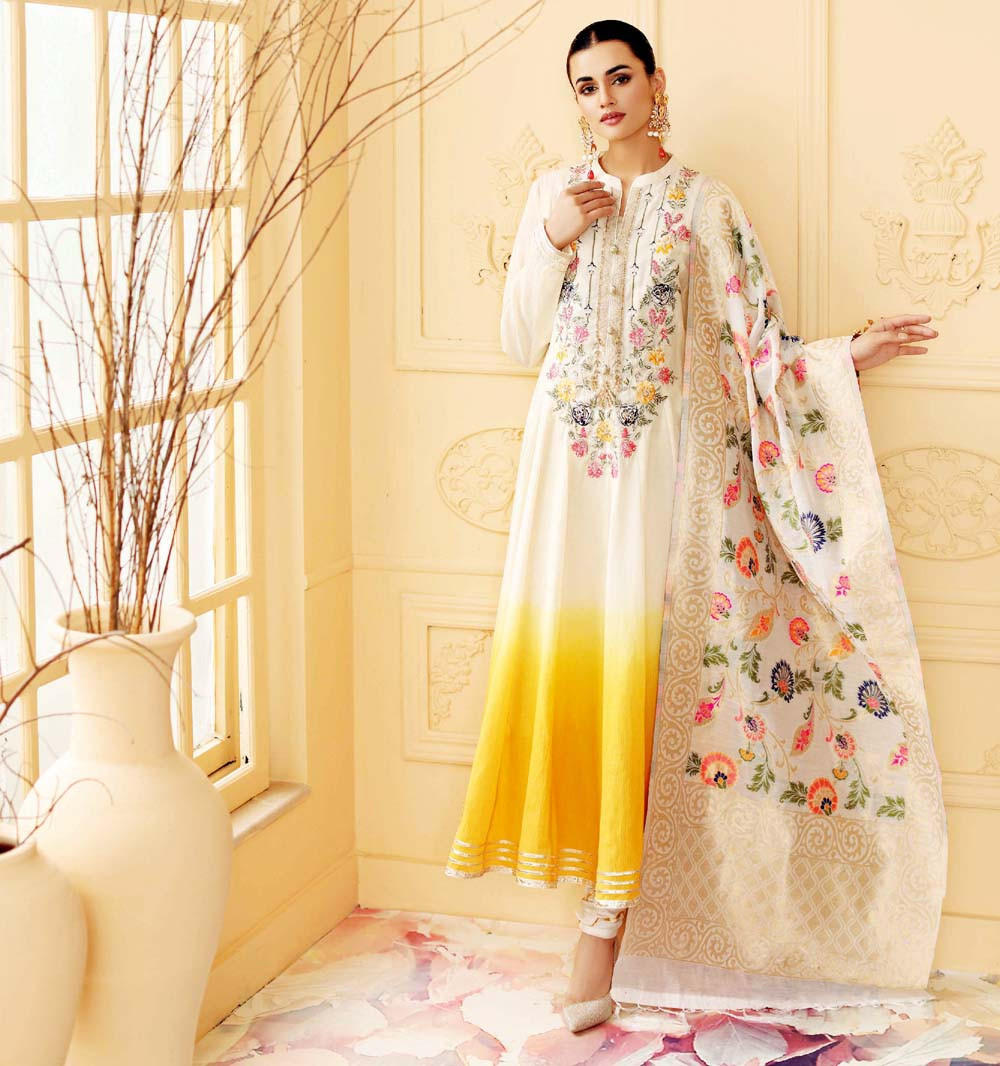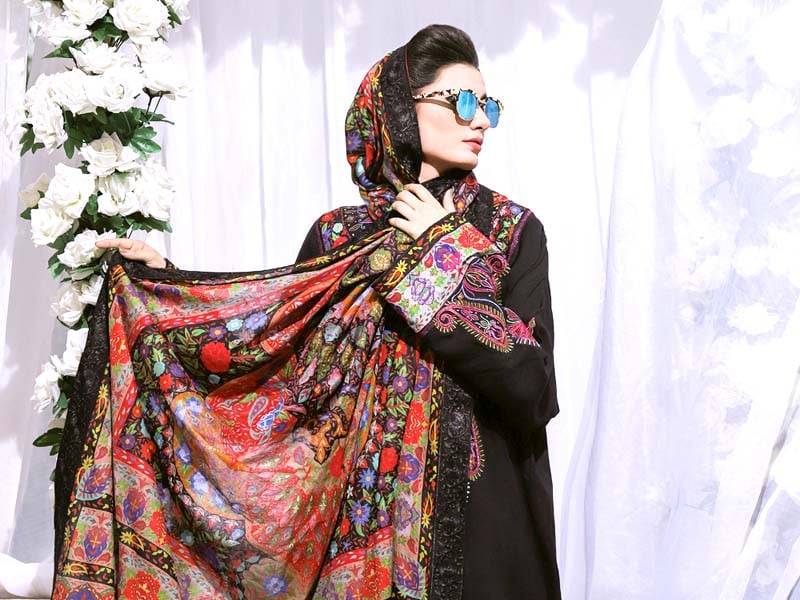STYLE: THE ENDURING ALLURE OF CRAFT
Maliha Rehman
May 2, 2021
Rizwan Beyg
Within Bunto Kazmi’s atelier, an embellished swathe of fabric moves beyond the generic realms of apparel and becomes art. An embroidered shawl may tell the story of a Tree of Life, or a heavenly garden inspired by Sharar’s Firdaus-i-Bareen may come to life.
Butterflies will flit on the canvas, their wings splayed out in myriad colours, trellises will wind past exotic flora. Every flower petal will have a unique shade and the miniature men and women will tell stories of their own, each with a different facial expression created with such startling precision that it’s hard to believe that they have been etched with thread and needle, and not with a paintbrush.
I have observed the veteran designer peer over her creations with the set of magnifying glasses that lie handy on her work desk. If an out-of-place stitch catches her eye, she may have the entire pattern taken out and reworked. This nitpicky obsession for perfection in every detail is what continues to make Bunto Apa’s work so coveted. It certainly isn’t ‘buy now see now’; but rather a design that is created to be cherished forever, an heirloom to pass on to later generations, refraining from following trends yet with an intrinsic beauty that makes it a timeless, unforgettable statement.
Such splendour, and the effort and expertise invested in creating it, comes at a considerable price, which is why the designer stopped bringing out Eid collections some years ago. The designs are extremely luxurious, perfect for festive occasions, but not everyone can afford a bona fide Bunto Kazmi.
With Eid round the corner, Icon casts an eye at the innate beauty of timelessness, created by veteran, revivalist couturiers through designs created with persnickety attention to detail, free from the shackles of immediate trends
A burgeoning crowd of designers cash in on this by delivering on fast fashion and even a modern-day, economical take on couture, where machine work may merge with a dash of hand embroidery and a heavy sprinkling of bling. Many of them run hugely successful businesses and yet, the artistry of a Bunto creation remains in a league of its own, sought-after even when it may not be easily viable.
Rizwan Beyg
A few paces away from Bunto’s atelier, another designer stays committed to her love for craft. “There isn’t a single machine in my workplace,” Faiza Samee tells me, leading me through racks bustling with exquisite design. Paisleys, lotuses and chrysanthemums crane their necks on her canvas, especially sketched out before translated to delicate threadwork. There are tunics replete with Ottoman inspirations, Moroccan wool embroideries, borders meshed together with tiny stitches and block prints on silk in a giddy whirl of colours.
Primary on her mind, though, is the ancient tradition that she’s keeping alive in her back garden, indigo dyeing, printing and manipulation with a clay indigo vat that she has been maintaining for four years now.
“The technique of dyeing with it isn’t simple, it’s a different ballgame altogether,” describes Faiza. “The vat has to be nurtured, which means that it needs to be ‘fed’ and stirred every day to keep it alive. It’s a living organism, much like a pet. If left unwatched for two or three days, it can die.
“It is a notorious medium to work with. I unlearnt all the rules of dyeing and printing the way I knew them. This dye actually relishes all kinds of acids and strong limes. The depth of colour comes with the processes of layering of the dye. The fabric has to be deprived of oxygen until the time when you’re ready to bring it out to be put in the sun.”
Faiza Samee
Twisting and dyeing the fabric, wielding it into glorious shades of violet, or following the Japanese Shibori method, it is hard work — but Faiza loves it. “For more than 40 years, I’ve woken up every morning excited about what I’ll be working on next,” she says.
This mastery and passion is an intrinsic part of Faiza Samee’s signature, placing her amongst one of Pakistan’s finest couturiers. Again, her unadulterated take on couture and craft ultimately leads to a hefty price tag. In recent times, such design would often get sequestered into a category reserved for affluent connoisseurs, but with the coronavirus slowing down life, the fashion industry’s endless pursuit of trends has up-ended into something more long-lasting.
There isn’t a party to go to every weekend, a wedding every month and — in theory, at least, though not in practice — social gatherings are smaller and socially distanced. Eidul Fitr, right round the corner, is also likely to be an understated affair. Cash flows are relatively low and the inclination for instant gratification through throwaway fashion and flashiness has lost its allure.
Replacing it is the innate beauty of timelessness; a design created with persnickety attention to detail, free from the shackles of trends, with its classic lines, and making a statement every time it is worn. The world has slowed down and there has been a reawakening in fashion to the immense possibilities and longevity of painstakingly created craft.
Shamaeel Ansari
In Pakistan, this particularly holds true because, moving beyond the veteran couturiers, newer labels creating formal-wear have also been teetering towards very high price points. Some may be exceptional, but many of today’s fashion success stories don’t have a defined aesthetic or a particular penchant for craft.
They make up for it with business acumen and massive marketing.
Megabrands have been built by piggybacking on celebrity brand ambassadors, fashion week theatrics and social media campaigns. As they gain mileage, their price points climb higher, often becoming approximately the same as genuine, well-crafted couture by a more exceptional design house.
In the pre-Covid-19 world, the very rich would frequent design houses around the time of a wedding or Eids, and order multiple outfits from high-end couturiers, as well as the newer labels. Today, people are buying less — one outfit instead of many — and there is a natural gravitation towards craft.
“Does Mahira Khan come with it?”
Umar Sayeed -Photos by Shahbaz Shazi
Not every customer, however, is willing to pay a heavy duty price even for genuine couture. With incomes contracting, designers reveal that there’s plenty of bargaining and complaints regarding the pricing. Designer Umar Sayeed’s ‘Eid Edit’, for instance, is a capsule line of delicately embroidered Kashmiri kurtas that are breathtakingly beautiful — but at a price.
“My regular customers realise the worth of the designs,” says Umar, “and I can’t do anything about those who don’t. They have loved the Kashmiri kurtas and the whites, particularly, have been huge hits. White is always a bestseller, come Eid.”
Evidently, Umar’s repute as a designer extraordinaire has not dissuaded walk-in buyers from making the occasional jibe. Referring to a recent fashion shoot, where his designs were seen on actress Mahira Khan, Umar laughs, “Some people, when they heard the price I was charging, sarcastically asked me if I was giving Mahira Khan along with the design. Not everyone today understands the worth of a garment that takes days to create, with every embellishment created entirely by hand.”
In an industry clustered with competition, Umar knows that this may mean that his market will always remain limited to an exclusive niche. “I don’t aspire for mass market anyway,” says the designer. “I cannot give up my love for craft, and the people who regularly come to me value it as much as I do.”
Craft and the business of fashion
Sonya Battla
Till some years ago, another veteran designer, Rizwan Beyg, used to be similarly dedicated to hand embellishment — until he was awakened to the possibilities held within fastidiously created machine embroideries. Rizwan worked with craftswomen in rural regions, harnessing their traditional needlework so that it had greater finesse, building a team that eventually became experts at what they did, and upped the ante for his brand.
This team still forms the backbone of his design sensibility and he continues to create exquisitely hand-embroidered designs. With changing times and greater competition, though, the retail racks at Rizwan Beyg’s store also have plenty of machine embroideries, or amalgams of machine and hand.
“We always get a design created by hand first by our team of rural craftspeople,” says Rizwan. “Then, when we translate it to machine, we do not remove the imperfections that are there. The overall ‘feel’ or effect of hand embroidery remains there.”
The ‘khaakas’ or outlines also follow the designer’s signature aesthetic: intricate paisleys and flora, necklines and side-slits worked with multiple borders. “The trick is to remain true to the brand’s ethos while also maintaining affordable prices,” pinpoints the designer. “This Eid, we have fully worked shirts that come with separate dupatta options — a heavier more expensive one and a lighter one.
Rizwan Beyg
“Small-scale weddings and engagements may take place right after Eid, and we have designs where the machine embroidery is worked with sequins. They could work well for Eid, or be dressed up for an event later. Different colour options are available, of course. It’s all very formal but at a price point that doesn’t intimidate customers into not making a purchase.”
Taking centre stage in his store in Karachi is a black-and-white hand-embellished shirt and dupatta worked with Parsi Gara embroidery. The ‘Kashmiri Gara’, has peacocks and florals on its landscape and the ‘Chinese Gara’, on another tunic, features dragons, phoenixes with pointy beaks and roses in full bloom.
“Some clients are committed to pure hand embellishments and these tunics are for them. The hand-worked designs will also be translated into similar patterns by machine, for clients wanting to purchase at lower price points,” says Rizwan.
Shamaeel Ansari
Similarly, at Shamaeel Ansari’s, the designer’s individualistic bold signature traverses heavy-duty luxury-wear, as well as priced-down formals. Merging craft with layering, textures and print, Shamaeel spins stories that delve into Mughal history, the regal glory of the Ottomans, Sufi poetry, and kings and queens of yore. With Eidul Fitr round the corner, she has come up with Guzel, a collection that follows a very pretty palette, and is set off by hand-embroidered patterns and print. The designer aesthetic is very visible, even though the price points have been adjusted to appeal to a market hit by a wave of the coronavirus yet again.
“It’s very important for a designer to understand the temperament of the customer and bring out collections that can be afforded at the time,” observes Shamaeel. “At the same time, I feel that it’s our duty to provide livelihood to the craftspeople whose work has been cut down drastically due to the pandemic. In Guzel, the patterns are all entirely hand-embroidered and a machine has only been used in applying the applique.”
Has business been hit yet again by the Covid-19 pandemic this Eid? “For me, it has been smooth sailing because I create design that doesn’t follow any ongoing trends. The clothes can be worn again and again, months or years later,” she says.
Umar Sayeed
Also, far from the madding crowd of generic retail, stands Sonya Battla, working with tie-and-dyes and hand-block prints on silk. Maheen Khan’s banarsi Koya fabric is another example of the wonders that can be spun with the human hand. Shehla Chatoor, Zaheer Abbas, Fahad Hussayn. Kamiar Rokni, Elan and Nilofer Shahid have always had a predilection for hand-embellishments. There are many others; design houses may not always be committed to detailed craft but many do delve towards it occasionally.
When they do, the result is design that is memorable rather than merely pretty, entrenched in craft that will never go out of style. Coping with life in a pandemic, battling depression, fear and economic instability, the world’s notions of fashion have gone through a metamorphosis. Beautiful everlasting design inspires, more than anything else — for Eid, and beyond.
Published in Dawn, ICON, May 2nd, 2021










































